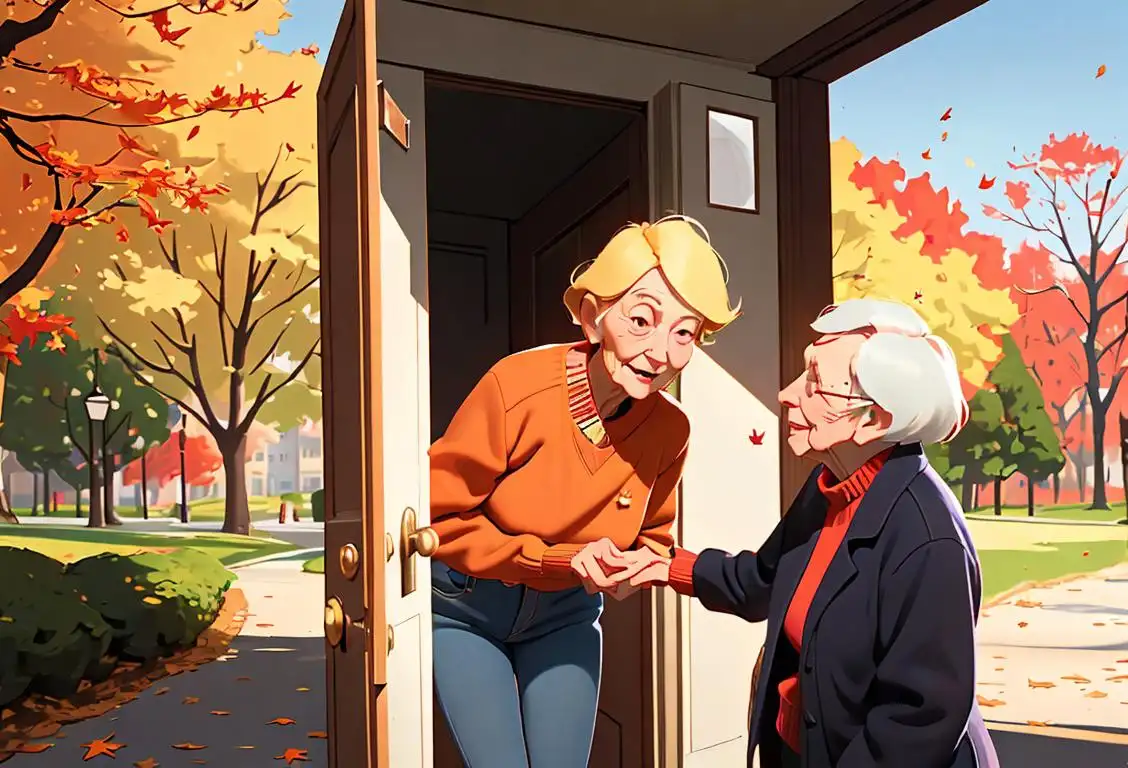National Dad Bod Day

Ah, National Dad Bod Day! The one day of the year where we celebrate the miraculous transformation of the male physique into something that can only be described as a cross between an inflatable pool toy and a cuddly teddy bear. It's a day that honors all the dads out there who proudly sport their dad bods with no shame whatsoever.
When is Dad Bod Day?
It's national dad bod day on the 21st June.
The Birth of the Dad Bod
Let's dive into the thrilling history of National Dad Bod Day! The term 'dad bod' first made its appearance in 2015, when a college sophomore named Mackenzie Pearson wrote an article for The Odyssey explaining why girls love the dad bod. It quickly went viral, and the dad bod trend exploded across the internet like an overinflated tire at a barbecue. Suddenly, dads everywhere embraced their newfound appreciation in the form of stretchy waistbands and effortless charm.
A Celebration of Love Handles and Happiness
On National Dad Bod Day, we celebrate the beautiful imperfections of the dad bod. It's a day to honor the love handles, the slightly protruding bellies, and the occasional underdeveloped biceps. But it's not just about the physical attributes - it's about the confidence and self-acceptance that come with embracing one's dad bod. It's about showing the world that you can be comfortable in your own skin, no matter the shape or size.
Activities for National Dad Bod Day
If you're wondering how to commemorate this auspicious occasion, fret not! We've got you covered with a few dad-approved suggestions:
- Host a dad bod fashion show, featuring the finest collection of oversized t-shirts and cargo shorts.
- Organize a dad bod Olympics, where dads compete in events like 'retrieving the TV remote from the couch cushions' and 'grilling the perfect burger'.
- Have a dad-themed movie marathon, featuring classics such as 'Dad Dancing: The Movie' and 'Snoring: A Symphony of Sleep'.
Did You Know?
History behind the term 'Dad Bod'
2015
The Birth of the Term
The term 'dad bod' was coined in 2015 by a Clemson University student, Mackenzie Pearson, in her article titled 'Why Girls Love the Dad Bod.' In her article, Pearson described the ideal physique as a softer, less toned body that is typically associated with fatherhood. She argued that 'dad bods' exude a sense of confidence, approachability, and comfort.
2014
Introduction of the term
The term 'dad bod' was first introduced in 2014 by a college student named Mackenzie Pearson in an article she wrote for the online publication 'The Odyssey'. She described the 'dad bod' as a physique that is somewhere between being ripped and overweight. According to Pearson, it's a body type characterized by a little extra weight, a slight beer belly, and a generally less toned appearance. Her article gained widespread attention and sparked a cultural conversation about body image.
2015
The Birth of a Term
In 2015, the term 'dad bod' gained popularity and entered the cultural lexicon. It refers to a physique commonly associated with men who are neither extremely fit nor overweight. The term quickly gained attention through an article written by Mackenzie Pearson, a then 19-year-old student at Clemson University. Her article, titled 'Why Girls Love the Dad Bod,' was published on The Odyssey, a social content platform.
2015
The birth of the term
The term 'dad bod' first gained traction in 2015, when Mackenzie Pearson, a student at Clemson University, wrote an article titled 'Why Girls Love the Dad Bod' for The Odyssey, an online platform for creators. Pearson described the dad bod as a physique that is somewhere between a beer gut and a muscular build. Her article went viral, sparking a widespread discussion about body positivity and attractiveness standards.
2015
The Birth of Dad Bod
The term 'dad bod' was coined in 2015 by Mackenzie Pearson, a then-19-year-old college student. In her article titled 'Why Girls Love the Dad Bod,' Pearson described the dad bod as a physique that was not overly muscular but still retained a touch of masculinity. She argued that this body type was attractive because it exuded a sense of comfort, approachability, and self-acceptance.
2015
Introduction of the Term
The term 'dad bod' first gained popularity in 2015. It refers to a physical body type that became a cultural fascination. The term was coined in a blog post titled 'Why Girls Love the Dad Bod' by Clemson University student Mackenzie Pearson. She described the dad bod as a physique that is neither overly muscular nor overweight, but rather a body that is slightly soft and round, often associated with being a father or a middle-aged man.
2015
Introduction of the term 'dad bod'
In 2015, the term 'dad bod' gained widespread attention and popularity. It refers to a physique typically associated with middle-aged men who are neither extremely fit nor overweight. The term was first popularized in an article written by Mackenzie Pearson, a then-student at Clemson University in South Carolina. Her article, titled 'Why Girls Love the Dad Bod,' went viral and sparked a cultural conversation about body positivity and attractiveness.
2015
Internet Sensation
The term 'dad bod' gained popularity in 2015 when a blog post titled 'Why Girls Love the Dad Bod' was published on The Odyssey, an online platform for writers. The term was coined to describe a physique that is neither completely fit nor overweight. It was used to refer to men who were perceived to have a comfortable, untoned body, often with a slight belly. The article argued that this type of body was seen as approachable, attractive, and relatable.
2015
The Birth of Dad Bod
In 2015, the term 'dad bod' rose to prominence in popular culture. It refers to a physique characterized by a slightly overweight or soft body, typically associated with men who are fathers. The term gained widespread attention after a blog post written by Mackenzie Pearson titled 'Why Girls Love the Dad Bod' went viral. The article celebrated the attractiveness of men who possess this body type, emphasizing their approachable and laid-back nature.
2015
Media Attention
Shortly after the blog post, the term 'dad bod' received widespread media attention. Various news outlets picked up the phrase, dissecting and discussing its meaning. The concept was embraced by both men and women, with many appreciating the idea of a less strict body norm and the confidence it represented. The term quickly became a part of popular culture and was widely used in online discussions, social media, and everyday conversations.
2015
Popularity and mainstream recognition
Following the viral success of Pearson's article, the term 'dad bod' quickly entered the cultural lexicon. It became a popular phrase used to describe a body shape characterized by a slightly softer and less toned physique, typically associated with men who are past their prime fitness years. Media outlets, such as The New York Times and The Washington Post, began discussing the concept extensively, further solidifying its place in popular culture.
2015
Social Media Buzz
Shortly after Mackenzie Pearson's article went viral, 'dad bod' became a trending topic on social media platforms. People from all walks of life joined the conversation, sharing images and discussing the concept. The term gained widespread attention and sparked a cultural fascination with the idea of the 'dad bod.' It started to shift the beauty standards away from the traditionally chiseled, muscular physique.
2015
Viral Sensation
Following the publication of Pearson's article, 'dad bod' quickly went viral, capturing the attention of media outlets and social media users worldwide. People resonated with the idea that a man's physique didn't have to adhere to strict societal standards, and it was refreshing to celebrate a body type that was seen as relatable and normal.
2015
Understanding the Appeal
The concept of the dad bod resonated with many people. It highlighted a body shape that was relatable and less focused on the pressure of having a perfectly chiseled physique. The term celebrated a more laid-back and attainable image for men, emphasizing a balance between staying in shape and enjoying life. This inclusivity and acceptance struck a chord with both men and women.
2015
Defining the Dad Bod
The term 'dad bod' quickly became a social media sensation, with countless memes and humorous posts circulating online. It captured a cultural shift in beauty standards, highlighting the acceptance and desirability of a body that deviates from the traditional expectations of chiseled abs and sculpted muscles. The dad bod became associated with being confident, comfortable in one's own skin, and prioritizing family and personal life over excessive fitness regimes.
2015
The term goes mainstream
Following the viral success of Mackenzie Pearson's article, the term 'dad bod' quickly spread across various media platforms, including social media, news outlets, and entertainment websites. It became a popular subject of discussion and was embraced by both men and women. 'Dad bod' was used to describe a body type that was seen as approachable, relatable, and less focused on intense fitness.
2015
Media Frenzy
After the blog post went viral, 'dad bod' quickly became a cultural phenomenon. Suddenly, everyone was talking about it. Major news outlets picked up the term, sparking debates and discussions about body positivity, attractiveness, and societal beauty standards. The media frenzy surrounding the term helped solidify its place in popular culture.
2015
Popularity and acceptance
In 2015, the term 'dad bod' gained significant popularity and acceptance in mainstream media. Celebrities like Leonardo DiCaprio and Chris Pratt were often cited as examples of the 'dad bod' physique, which further contributed to its growing cultural recognition. The term began to be seen as a positive and relatable body image rather than something to be criticized or mocked.
2016
Ode to Dad Bod
In 2016, Macklemore and Ryan Lewis released a song titled 'Brad Pitt's Cousin,' which playfully praised the dad bod. The lyrics celebrated the confidence and charisma associated with this body type, once again emphasizing that perfection wasn't necessary for attractiveness.
2016
Oxford Dictionary recognition
In 2016, the term 'dad bod' was officially recognized by the Oxford English Dictionary (OED). It was added to the dictionary as an informal noun, defined as 'a physique that is typically regarded as having a slight excess of flabby tissue around the waistline but is not overweight.' This inclusion in a renowned dictionary solidified the term's cultural impact and longevity.
2015
Accepted and Embraced
The term 'dad bod' resonated with many people, both men and women, who felt that it represented a realistic and attainable standard of beauty. It challenged the notion that only perfectly toned, chiseled bodies were desirable. 'Dad bod' began to be used in a lighthearted and affectionate way, with individuals embracing and celebrating their own dad bods. It became a symbol of confidence, self-acceptance, and body positivity.
2015
Positive Body Image
One of the reasons the dad bod gained popularity was its association with positive body image. People appreciated the dad bod as a more realistic and relatable body type, challenging the societal norms of fitness and perfection. The term celebrated a body that was imperfect yet loved, highlighting the beauty of self-acceptance and confidence. Many individuals, particularly men, embraced the dad bod as a non-judgmental way to feel comfortable in their own skin.
2016
Cultural acceptance and body positivity
As the term 'dad bod' gained momentum, it also sparked a larger conversation about body acceptance and self-confidence. Many people appreciated the idea that there could be beauty and attractiveness in various body types, challenging the conventional standards set by the media. The term 'dad bod' served as a reminder that physical appearance does not solely define attractiveness, and that personality and other qualities are equally important.
2015
Celebrity Endorsements
As the popularity of the 'dad bod' concept grew, several celebrities embraced and celebrated their own dad bods. Notable figures such as Leonardo DiCaprio, Chris Pratt, and Jason Segel were praised for their relaxed and less sculpted bodies. Their confident and carefree attitudes further reinforced the positive perception of the 'dad bod' and added to its cultural significance.
2015-Present
Pop Culture Recognition
Following the viral success of the term, 'dad bod' became a key reference in pop culture. It started appearing in various media outlets, TV shows, and movies, further solidifying its place in contemporary language. It even sparked discussions and debates about societal beauty standards and body positivity.
2016
The dad bod debate
In 2016, the dad bod phenomenon sparked a debate about body image and societal expectations. Some argued that the term celebrated an unhealthy lifestyle and promoted body shaming, while others saw it as a refreshing departure from unrealistic beauty standards. The discussion highlighted the ongoing discourse around body positivity and the need to embrace diverse body types.
2016
Pop Culture Recognition
In 2016, the popular television show 'Saturday Night Live' dedicated a sketch to the dad bod phenomenon, further cementing its place in pop culture. The sketch, titled 'The Dad Bod Fashion Show,' playfully showcased models sporting various dad bod styles while celebrating the carefree attitude and relatability associated with the body type. This recognition from a mainstream comedy show demonstrated that the dad bod had become more than just a passing trend.
2015
Humor and Lightheartedness
Another key aspect of the dad bod phenomenon was the humor and lightheartedness associated with it. The term was often used playfully, poking fun at the idea of a relaxed and slightly out-of-shape physique. Memes, jokes, and funny anecdotes about embracing the dad bod quickly spread across the internet. The humor surrounding the term helped to create a sense of camaraderie and acceptance while challenging traditional body standards.
2019
Research and Social Perception
In 2019, a study published in the journal 'Sex Roles' explored the cultural perception of the dad bod. The research found that women viewed men with a dad bod as more confident, relaxed, and attractive for long-term relationships compared to men with more muscular bodies. The study shed light on how society's perception of attractiveness goes beyond conventional standards.
2016
Added to Dictionaries
In 2016, the term 'dad bod' officially entered the lexicon of popular culture. It was added to various dictionaries, including the Oxford Dictionaries, recognizing its widespread usage and cultural significance. The term's inclusion in dictionaries further solidified its place as a recognized and accepted term in the English language.
2016
Inclusion in Dictionaries
In 2016, the term 'dad bod' officially entered mainstream language and was included in major English dictionaries. The Oxford English Dictionary and Merriam-Webster added 'dad bod' to their lexicons, acknowledging its cultural impact and widespread usage. Its inclusion solidified the term's status as a recognized concept in popular culture.
2017
Dad Bod Acceptance
By 2017, the dad bod had gained significant acceptance and even inspired major fashion brands to cater to this body type. Some clothing companies began producing lines specifically designed with the dad bod in mind, offering comfortable and stylish options to accommodate a wider range of body shapes. This acknowledgment from the fashion industry highlighted a more inclusive and realistic approach to men's body image.
2017
Research on 'dad bod' attractiveness
In 2017, a study conducted by researchers at the University of Bath in the United Kingdom examined the attractiveness of 'dad bods.' The findings suggested that men with a 'dad bod' were perceived as more caring, invested in relationships, and likely to be better long-term partners compared to men with more muscular or overweight physiques. This research further fueled the discourse around the term and its positive cultural impact.
2016
Celebrity endorsements
The dad bod trend caught the attention of celebrities, further intensifying its cultural impact. Actors like Leonardo DiCaprio and Chris Pratt were cited as examples of celebrities who embodied the dad bod aesthetic. Their influence helped to normalize and popularize the concept, leading to its widespread acceptance among men and women alike.
2019
Embraced as a cultural trend
By 2019, the 'dad bod' had become more than just a term. It had evolved into a cultural trend that celebrated a more relaxed and accepting attitude towards body image. The concept of the 'dad bod' represented a departure from the unrealistic beauty standards often associated with male physiques. It emphasized the idea that a person's attractiveness should not solely depend on their physical appearance but also on their confidence and personality.
2017
Official Recognition
In 2017, 'dad bod' was officially added to the Merriam-Webster dictionary. This recognition by a renowned dictionary showcased the term's widespread usage and cultural significance. It became a testament to how language evolves and reflects societal trends and attitudes towards body image.
2017
The dad bod workout
In 2017, fitness enthusiasts and trainers began developing workout routines specifically tailored to achieving a dad bod. These workouts aimed to strike a balance between maintaining a healthy lifestyle and embracing a slightly less chiseled physique. The dad bod workout routines gained popularity as a means of challenging traditional beauty standards and encouraging body acceptance.
2017
Dad Bod Evolution
In subsequent years, the dad bod trend evolved and expanded. The term began to encompass not just the physical appearance but also the behaviors and attitudes associated with fatherhood. It became a symbol of being caring, nurturing, and confident in one's own skin. The dad bod was no longer solely defined by physical traits but had a deeper, more emotional significance, reflecting a shift in societal perceptions of masculinity.
2020
Dad Bod Today
In recent years, the dad bod has continued to resonate with people as a relatable and positive concept. It has evolved beyond a mere physical description and has become emblematic of a particular lifestyle and attitude. Today, the dad bod represents a rejection of body shaming and unrealistic beauty standards for men. It symbolizes self-acceptance, authenticity, and a prioritization of overall well-being over striving for an idealized physique.
2020
Continued Popularity
The popularity of the 'dad bod' has only continued to grow over the years. It has transcended being just a term for a body type and has come to represent a broader mindset. The term encapsulates self-acceptance, confidence, and the rejection of rigid beauty standards. As society becomes more focused on body positivity and inclusivity, the 'dad bod' remains a cultural touchstone.
Present
Continued relevance and influence
In the present day, the term 'dad bod' remains a popular and recognized term that is widely used and understood in various contexts. It has inspired conversations about body positivity, challenging unrealistic beauty ideals, and embracing diverse body types. The 'dad bod' has become a symbol of acceptance and a reminder that everyone deserves to feel comfortable in their own skin, regardless of societal expectations.
2018
'Dad bod' in popular culture
By 2018, 'dad bod' had firmly established itself in popular culture. The term appeared in television shows, movies, and advertisements. It was often used humorously or as a characteristic associated with a lovable and relatable male character. Its presence in popular media further solidified the acceptance and understanding of body diversity.
2017
Parody and Humor
In subsequent years, the 'dad bod' concept became a subject of parody and humor. Comedians and internet memes playfully highlighted the supposed perks of having a 'dad bod' and joked about its appeal. The term, once a genuine reflection of changing beauty ideals, embraced a lighthearted and humorous tone in popular culture.
2020
Ongoing Popularity
Today, the term 'dad bod' continues to be used and celebrated. It has become a staple in discussions about body image, masculinity, and societal expectations. 'Dad bod' represents a shift towards embracing diverse body types and challenging traditional beauty standards. It serves as a reminder that attractiveness comes in various forms, and that self-acceptance and confidence are more important than conforming to societal ideals.
Present
Continued cultural relevance
Today, the term 'dad bod' continues to be part of popular culture and the ongoing discussion around body positivity. It represents a shift in beauty ideals towards a more inclusive and accepting notion of attractiveness. The term has evolved to encompass a broader definition that extends beyond gender, emphasizing the acceptance of diverse body types and the celebration of individuality.
Present
Continued Popularity
Even though the initial hype around the 'dad bod' has subsided, the term continues to resonate with many individuals. It challenges societal expectations of physical perfection and promotes body acceptance. The 'dad bod' represents a shift toward appreciating a more realistic and inclusive standard of attractiveness. It remains a powerful symbol of self-acceptance and celebrates the beauty of diversity in body shapes.
Did you know?
The term 'dad bod' was added to the Oxford English Dictionary in 2016, cementing its place in the annals of body positivity.Tagged
romance fun loved onesFirst identified
9th June 2015Most mentioned on
21st June 2015Total mentions
52Other days
Love Your Red Hair Day
Do Something Nice Day
Suicide Prevention Month Day
Kissing Fried Chicken Day
Kiss A Ginger Day
Iloveyou Day
Compliment Day
Happiness Day
Tv On The Same Day
Boyf Day









